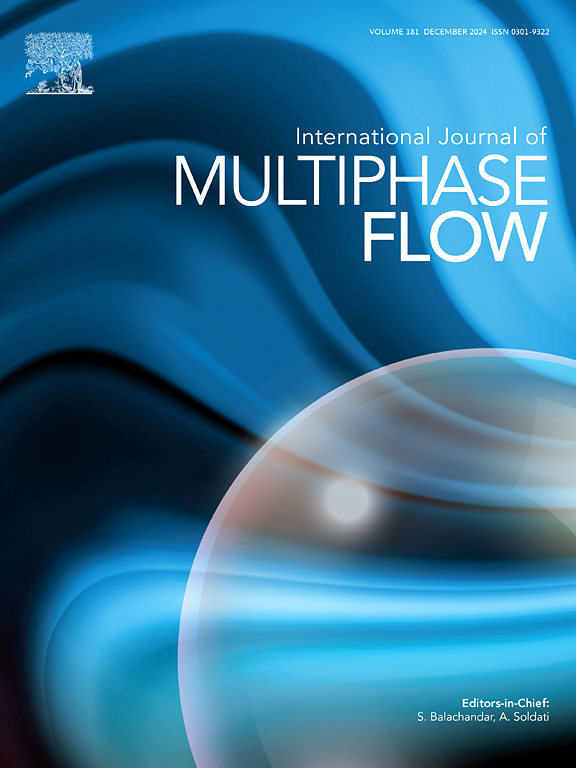The influence of drag, lift and torque modelling on the dynamics of ellipsoidal particles in a turbulent channel flow
IF 3.6
2区 工程技术
Q1 MECHANICS
International Journal of Multiphase Flow
Pub Date : 2025-02-19
DOI:10.1016/j.ijmultiphaseflow.2025.105176
引用次数: 0
Abstract
Direct numerical simulation is coupled with a Lagrangian point-particle tracking to study the dynamics of inertial prolate ellipsoids in a turbulent channel flow. Two models are employed to compute the hydrodynamic force and torque acting on the ellipsoids in order to assess the influence of the fluid inertia. The first one is an analytical model derived under the assumption of a creeping flow motion at the particle scale while the second model relies on semi-empirical correlations to account for the effect of the fluid inertia on the hydrodynamic actions. For spherical and ellipsoidal particles alike, the hydrodynamic actions model has a weak influence on the probability density function of the particle Reynolds number and on their translational velocity statistics. The hydrodynamic actions modelling however strongly affects the near-wall rotation of weakly and moderately inertial ellipsoids, owing to the different rotation orbits favoured by the ellipsoids. This causes significant variations of the mean orientation and of the ellipsoids angular velocity statistics. In contrast, the rotational dynamics of highly inertial ellipsoids weakly depends on the hydrodynamic actions modelling in the near-wall region, but significantly varies in the buffer region. This effect is associated with the torque generated by the particle motion relative to the surrounding fluid, which results in a strong enhancement of the particle angular velocity fluctuations. Preferential alignment of the ellipsoids normal to the relative translational velocity vector is observed when the inertial effects are accounted for, corresponding to recent experimental observations and theoretical developments.

阻力、升力和扭矩模型对湍流通道中椭球颗粒动力学的影响
采用直接数值模拟与拉格朗日点-粒子跟踪相结合的方法,研究了湍流通道中惯性长形椭球体的动力学特性。为了评估流体惯量对椭球体的影响,采用两个模型分别计算了作用在椭球体上的水动力和扭矩。第一个模型是在假设蠕变流动在颗粒尺度下推导的解析模型,而第二个模型依赖于半经验关联来解释流体惯性对水动力作用的影响。对于球形和椭球状粒子,水动力作用模型对粒子雷诺数的概率密度函数和它们的平移速度统计量的影响都很弱。然而,由于弱惯性和中等惯性椭球的旋转轨道不同,流体动力作用的建模强烈影响椭球的近壁旋转。这导致平均方向和椭球角速度统计的显著变化。相比之下,高惯性椭球体的旋转动力学对近壁区流体动力作用建模的依赖程度较弱,但在缓冲区内变化显著。这种效应与颗粒相对于周围流体运动产生的扭矩有关,这导致颗粒角速度波动的强烈增强。根据最近的实验观察和理论发展,当考虑惯性效应时,观察到椭球体偏向于相对平移速度矢量。
本文章由计算机程序翻译,如有差异,请以英文原文为准。
求助全文
约1分钟内获得全文
求助全文
来源期刊
CiteScore
7.30
自引率
10.50%
发文量
244
审稿时长
4 months
期刊介绍:
The International Journal of Multiphase Flow publishes analytical, numerical and experimental articles of lasting interest. The scope of the journal includes all aspects of mass, momentum and energy exchange phenomena among different phases such as occur in disperse flows, gas–liquid and liquid–liquid flows, flows in porous media, boiling, granular flows and others.
The journal publishes full papers, brief communications and conference announcements.

 求助内容:
求助内容: 应助结果提醒方式:
应助结果提醒方式:


